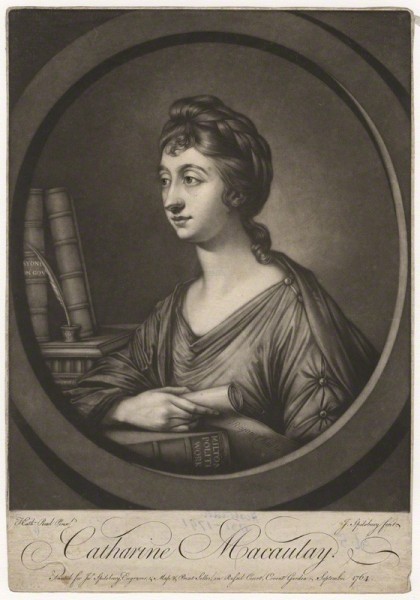
Catharine Macaulay (née Sawbridge) line engraving by Williams, 1770, after a painting by Katharine Read © National Portrait Gallery, London.
A passionate democrat is lamenting the lost liberties of the Republic of Rome.
She was respected and celebrated in Britain, France and America, by politicians as diverse as Pitt the Elder, Mirabeau, Thomas Jefferson, Samuel Adams and George Washington, who wanted her to write the history of the American Revolution. As an historian and political theorist she was regarded as the adversary and equal of her male contemporaries David Hume, Edward Gibbon and Edmund Burke, and was more progressive, more recognizably modern to us, than any of them.
Now, most of us have never heard of her. I bumped into her for the first time a month ago when I was looking for more 18th century women with “a taste for books”, as she put it.
The process of shunting her out of his-story, started in her lifetime. As she got older, her extreme radicalism, particularly her support of the French Revolution, and unconventional private life shocked a lot of people, who cast her out of their polite society. She didn’t seem to miss it.
Clever middle-aged women who refuse to conform, who continue to innovate and prefer dancing on the precipice to knitting socks for their grandchildren, are still not taken seriously today: audiences love to see them fall.
She was born into recently landed gentry whose wealth had come from banking, typical of early 18th century social and economic mobility. Her political theories were rooted in the ‘Roundhead’ tradition of John Hampden, the true hero of parliamentarianism in her view, not the tyrant Oliver Cromwell, who became crypto-king.
She ranged far left of the Whig ideology in which she had been raised, far outside the accepted lines of class, sex and age. Personal liberty and equality, and the courage of personal conviction, mattered more to her than social approval.
When she was forty-seven, having been a widow for twelve years, she overturned every kind of received idea by marrying a twenty-one year old ‘surgeon’s mate’, the younger brother of a celebrity quack doctor.
She was still a star of liberty in the new American Republic, and was welcomed, accompanied by her husband, to George Washington’s house for a visit which lasted ten days. She was the President’s first choice to write the history of the Revolution; by then in her late fifties, she felt too physically frail for the task; only a terminal illness would have stopped her.
After her death, her husband, William Graham, erected a monument commemorating her wisdom in All Saints’ Church, Binfield, in Berkshire. Most other English people buried her intellectual achievements along with her body, and her radical contribution to political theory and history was forgotten in the next century.
This was partly because monarchical systems of government and opposition to universal suffrage triumphed in post-Napoleonic Europe, partly because she was a woman, a very inconvenient woman, whose intellectual challenge to a man’s world could be dismissed as menopausal hysteria, her rational voice shouted down in a chorus of “Calm down, dear” [the remark made by UK Prime Minister David Cameron in parody of the TV advert featuring Michael Winner, to MP Angela Eagle during a parliamentary debate in 2011].

Catharine Macaulay (née Sawbridge) by James Basire, after Giovanni Battista Cipriani,
line engraving, published 1767. Image: © National Portrait Gallery, London
Now, when we see that liberty and equality are as fragile as ever, she is understood and relevant again.






 Polly Kennedy (Polly Jones) published by John Bowles, mezzotint after a painting by Katherine Read, 1770s. Image: © National Portrait Gallery, London
Polly Kennedy (Polly Jones) published by John Bowles, mezzotint after a painting by Katherine Read, 1770s. Image: © National Portrait Gallery, London
